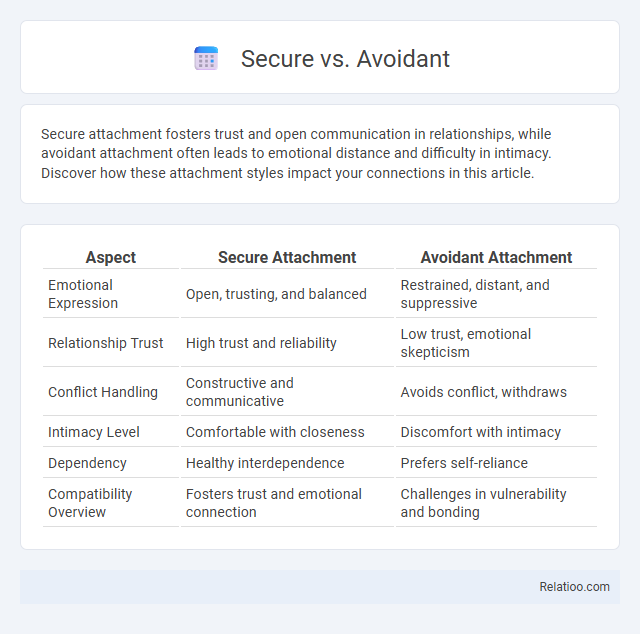Secure attachment fosters trust and open communication in relationships, while avoidant attachment often leads to emotional distance and difficulty in intimacy. Discover how these attachment styles impact your connections in this article.
Table of Comparison
| Aspect | Secure Attachment | Avoidant Attachment |
|---|---|---|
| Emotional Expression | Open, trusting, and balanced | Restrained, distant, and suppressive |
| Relationship Trust | High trust and reliability | Low trust, emotional skepticism |
| Conflict Handling | Constructive and communicative | Avoids conflict, withdraws |
| Intimacy Level | Comfortable with closeness | Discomfort with intimacy |
| Dependency | Healthy interdependence | Prefers self-reliance |
| Compatibility Overview | Fosters trust and emotional connection | Challenges in vulnerability and bonding |
Understanding Attachment Styles: Secure vs Avoidant
Understanding attachment styles reveals how Secure attachment fosters trust, emotional openness, and healthy relationship boundaries, while Avoidant attachment often leads to emotional distance and reluctance in intimacy. Your ability to recognize these patterns can enhance communication and emotional connection in your relationships. Secure attachment promotes resilience and support, whereas Avoidant attachment may cause challenges in expressing needs and maintaining closeness.
Key Traits of Secure Attachment
Secure attachment is characterized by trust, emotional openness, and the ability to seek comfort when distressed, fostering healthy and stable relationships. Individuals with a secure attachment style display confidence in their partner's availability and responsiveness, promoting effective communication and empathy. This attachment style contributes to emotional regulation, resilience, and positive social interactions.
Hallmarks of Avoidant Attachment
Avoidant attachment style is characterized by emotional distance, difficulty trusting others, and a strong preference for self-reliance, often stemming from early caregiving that discouraged emotional expression. Individuals with avoidant attachment commonly suppress feelings and avoid intimacy, making it challenging to form close, trusting relationships. This contrasts with secure attachment, which fosters comfort with closeness and trust, highlighting the significance of early relational experiences in shaping attachment behaviors.
Emotional Intimacy: Secure vs Avoidant Responses
Secure attachment style fosters emotional intimacy through trust, open communication, and consistent support, allowing you to comfortably express vulnerability and connect deeply. Avoidant attachment style often results in emotional distance, reluctance to share feelings, and difficulty in sustaining close bonds, hindering genuine intimacy. Understanding these contrasting responses helps improve relationship dynamics and promotes healthier emotional connections.
Conflict Resolution in Secure and Avoidant Relationships
Secure attachment styles promote healthy conflict resolution through open communication, emotional understanding, and mutual trust, enabling partners to address disagreements constructively. Avoidant attachment often leads to conflict avoidance, emotional withdrawal, and difficulty expressing needs, which can hinder effective resolution and escalate tensions. Your ability to recognize these patterns can improve relationship dynamics and foster more constructive conflict management.
Communication Patterns: Comparing Secure and Avoidant
Secure attachment fosters open, honest communication, where emotions are expressed clearly and partners feel safe discussing vulnerabilities. Avoidant attachment often results in emotional distancing, reduced self-disclosure, and deflecting or minimizing conflicts to maintain independence. These contrasting patterns significantly impact relationship satisfaction and intimacy levels between partners.
Childhood Influences Shaping Attachment Styles
Early childhood experiences with caregivers critically shape attachment styles, where secure attachment develops from consistent and responsive caregiving, fostering trust and emotional regulation. Avoidant attachment emerges from emotionally distant or unresponsive caregivers, leading to self-reliance and suppressed emotional expression. In contrast, anxious attachment is often a result of inconsistent caregiving, causing heightened sensitivity to rejection and constant seeking of reassurance.
Secure vs Avoidant: Impact on Romantic Relationships
Secure attachment fosters healthy romantic relationships with open communication, emotional intimacy, and trust, promoting long-term stability and satisfaction. Avoidant attachment often leads to emotional distance, reluctance to commit, and challenges in expressing feelings, resulting in misunderstandings and conflict. Research demonstrates that partners with secure attachment styles experience higher relationship quality and resilience compared to those with avoidant tendencies.
Overcoming Avoidant Tendencies: Toward Security
Overcoming avoidant tendencies requires recognizing emotional detachment patterns and practicing vulnerability to build trust in relationships. Consistent self-awareness and intentional connection efforts help shift avoidant attachment toward secure attachment, enhancing intimacy and emotional resilience. Therapeutic approaches like cognitive-behavioral therapy and mindfulness support the development of secure attachment by addressing fears of dependence and improving emotional regulation.
Building Healthier Connections: Insights and Strategies
Understanding your attachment style--secure, avoidant, or anxious--plays a crucial role in building healthier connections by influencing how you relate to others emotionally. Secure attachment fosters trust and open communication, while avoidant attachment often leads to emotional distance, and anxious attachment may cause dependency and fear of abandonment. By recognizing these patterns, you can develop strategies to cultivate emotional resilience, improve empathy, and establish more balanced, fulfilling relationships.

Infographic: Secure vs Avoidant
 relatioo.com
relatioo.com